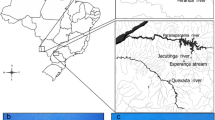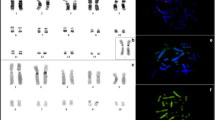Abstract
To complement our knowledge about the karyotypes of the genus Vernonia Schreb., different techniques of chromosome banding, including AgNOR, triple staining with fluorochromes CMA/DA/DAPI (CDD), and fluorescence in situ hybridization (FISH) for the 45S rDNA probe, were applied to three species of subsection Macrocephalae. Vernonia bardanoides was collected from an area of cerrado (savanna) vegetation in Itirapina, São Paulo State, Brazil, and V. linearifolia and V. tomentella were collected from areas of rocky, open altitudinal vegetation in Joaquim Felicio and Diamantina, respectively, in Minas Gerais State. All species showed two terminal CMA+ and NOR bands. FISH indicated two terminal 45S rDNA sites in V. linearifolia and V. tomentella, and six in V. bardanoides.

Similar content being viewed by others
References
Appels R, Moris R, Gill S, May C (1998) Chromosome biology. Kluwer, Boston
Baker JG (1873) Compositae I. Vernonieae. In: Martius CFP, Eichler AG (eds) Flora brasiliensis, vol 6(2). Lipsiae, Monachii
Bentham G (1873) Compositae. In: Bentham G, Hooker JD (eds) Genera Plantarum, vol 2. Lovell Reeve, London
Berger R, Greilhuber J (1993) C-bands and chiasma distribution in Scilla amoena, S. ingridae, and S. mischtschenkoana (Hyacinthaceae). Plant Syst Evol 184:125–137
Bremer K (1994) Asteraceae, cladistics and classification. Timber Press, Portland
Cerbah M, Coulaud J, Godelle B, Siljak-Yakovlev S (1995) Genome size, fluorochrome banding and karyotype evolution in some Hypochaeris (Asteraceae). J Hered 38:689–695
Cuadrado A, Jouve N (1994) Mapping and organization of highly-repeated DNA sequences by means of simultaneous and sequential FISH and C-banding in 6x-triticale. Chromosome Res 2:331–338
Dematteis M (1997) Números cromosómicos y cariotipos de algunas espécies de Vernonia (Asteraceae). Bol Soc Argent Bot 33(1-2):85–90
Dematteis M (1998) Chromosome studies of some Vernonia species (Asteraceae). Genet Mol Biol 21:381–385
Dematteis M (2002) Cytotaxonomic analysis of South American species of Vernonia (Vernonieae: Asteraceae). Bot J Linn Soc 139:401–498
Dematteis M, Fernández A (1998) karyotypes of seven South American species of Vernonia (Asteraceae). Cytologia 63:323–328
Fregonezi JN, Torezan JMD, Vanzela ALL (2004) A karyotypic study of three southern Brazilian Asteraceae species using fluorescence in situ hybridization with a 45S rDNA probe and C-CMA3 banding. Genet Mol Biol 27(2):223–227
Galasso I, Schmidt T, Pignone D, Heslop-Harrison JS (1995) The molecular cytogenetics of Vigna unguiculata (L.) Walp: the physical organization and characterization of 18S-5.8S-25S rRNA genes, 5S genes, telomere-like sequences, and a family of centromeric repetitive DNA sequences. Theor Appl Gen 9:928–935
Garnatje T, Vallés J, Vilatersana R, Garcia-Jacas N, Susanna A, Siljak-Yakovlev S (2004) Molecular cytogenetics of Xeranthemum L. and related genera (Asteraceae, Cardueae). Plant Biol 6:140–146
Guerra M (1988) Introdução à citogenética Geral. Editora Guanabara, Rio de Janeiro
Jones SB (1979) Chromosome numbers of Vernonieae (Compositae). Bull Torrey Bot Club 106:79–86
Keeley SC, Jansen RK (1994) Chloroplast DNA restriction site variation in the Vernoniaeae (Asteraceae), an initial appraisal of the relationships of New and Old World taxa and the morphology of Vernonia. Plant Syst Evol 193:249–265
Keeley SC, Forsman ZH, Chan R (2007) A phylogeny of the “evil tribe” (Vernonieae: Compositae) reveals Old/New World long distance dispersal: support from separate and combined congruent datasets (trnL, ndhF, ITS). Mol Phyl Evol 44:89–103
Levin DA (2002) The role of chromosomal change in plant evolution. Oxford University Press, New York
Moscone EA, Loidl J, Ehrendorfer F, Hunziker AT (1995) Analysis of active nucleolus organizing regions in Capsicum (Solanaceae) by silver staining. Am J Bot 82:276–287
Moscone EA, Lambrou M, Ehrendorfer F (1996) Fluorescent chromosome banding in the cultivated species of Capsicum (Solanaceae). Plant Syst Evol 202:37–63
Murray BG, Bennett MD, Hanmet RW (1992) Secondary constrictions and NORs of Lathyrus investigated by silver staining and in situ hybridization. Heredity 68:473–478
Oliveira VM, Forni-Martins ER, Semir J (2007a) Cytotaxonomy of species of Vernonia, section Lepidaploa, group Axilliflorae (Asteraceae, Vernonieae). Bot J Linn Soc 154:99–108
Oliveira VM, Forni-Martins ER, Semir J (2007b) Cytotaxonomic studies in six species of Vernonia (Asteraceae:Vernonieae). Caryologia 60:37–47
Oliveira VM, Forni-Martins ER, Semir J (2010) Chromosome numbers in the old genus Vernonia (Asteraceae) and their taxonomic significance. Cur Top Plant Biol 11:29–37
Oliveira VM, Forni-Martins ER, Semir J (2011a) Chromosome numbers and karyotypes of species of Vernonia sect. Lepidaploa (Asteraceae: Vernonieae). Folia Geobot. doi: 10.1007/s12224-011-9103-z
Robinson H (1988) Studies in the Lepidaploa complex (Vernonieae: Asteraceae) IV, The new genus Lessinglanthus. Proc Biol Soc Wash 100(4):929–951
Robinson H (1999) Generic and subtribal classification of American Vernonieae. Smith Contrib Bot 89:1–116
Robinson H (2007) Tribe Vernonieae. In: Kadereit J, Jeffrey C (eds) The families and genera of vascular plants. Vol VIII. Flowering plants: Eudicots, Asterales. Springer, Berlin, pp 149–174
Robinson H, Funk VA (1987) A phylogenetic analysis of Leiboldia, Lepidonia, and a new genus Stramentopappus (Vernonieae: Asteraceae). Bot Jahr Syst 108:213–228
Robinson H, Kahn B (1986) Trinervate leaves, yellow flowers, tailed anthers, and pollen variation in Distephanus Cassini (Vernonieae:Asteraceae). Proc Biol Soc Wash 99:493–495
Salles-de-Melo MRC, Lucena RM, Semir J, Carvalho R, Pereira RCA, Benko-Iseppon AM (2010) Karyological features and cytotaxonomy of the tribe Vernonieae (Asteraceae). Plant Syst Evol 285:189–199
Vanzela ALL, Guerra M (2000) Heterochromatin differentiation in holocentric chromosomes of Rhynchospora (Cyperaceae). Genet Mol Biol 23(2):453–456
Vanzela ALL, Ruas CF, Oliveira MF, Ruas PM (2002) Characterization of diploid, tetraploid and hexaploid Helianthus species by chromosome banding and FISH with 45S probe. Genetica 114:105–111
Weiss-Schneeweiss H, Stuessy T, Siljak-Yakovlev S, Baeza C, Parker J (2003) Systematic and evolutionary implications of karyotypes of Hypochaeris (Asteraceae, Lactuceae) from South America. Plant Syst Evol 241:171–184
Acknowledgments
V.M.O was supported by a scholarship from Fundação de Amparo à Pesquisa do Estado de São Paulo (FAPESP) and E.R.F.M. by a research fellowship from Conselho Nacional de Desenvolvimento Científico e Tecnológico (CNPq). This work was funded by FAPESP (grant no. 04/13165-9).
Author information
Authors and Affiliations
Corresponding author
Rights and permissions
About this article
Cite this article
de Oliveira, V.M., Semir, J. & Forni Martins, E.R. Banding and FISH in three species of Vernonia, subsection Macrocephalae (Asteraceae, Vernonieae). Plant Syst Evol 298, 969–974 (2012). https://doi.org/10.1007/s00606-012-0606-8
Received:
Accepted:
Published:
Issue Date:
DOI: https://doi.org/10.1007/s00606-012-0606-8




